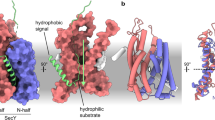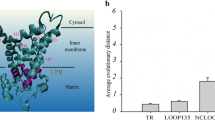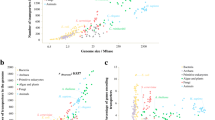Summary
The comparison of the amino acid sequences of four yeast transport proteins indicates that there is a questionable relatedness between the uracil permease (FUR4) and the purine-cytosine permease (FCY2), whereas the arginine permease (CAN1) and the histidine permease (HIP1) clearly originated from a common molecular ancestor. The analysis of the primary structure of these transport proteins by two methods of secondary structure predictions suggests the presence of 9–12 membrane-spanning α-helices in each polypeptide chain. These results are concordant in that 90% of the α-helices were determined by both methods to be at the same positions. In the aligned sequencesHIP1 andCAN1, the postulated membrane-spanning α-helices often start at corresponding sites, even though the overall sequence similarity of the two proteins is only 30%. In the aligned DNA coding sequences ofCAN1 andHIP1, synonymous nucleotide substitutions occur with very similar frequencies in regions where the replacement substitution (changing the amino acids) frequencies are widely different. Moreover, our data suggest that the replacement substitutions can be considered as neutral in the N-terminal segment, whereas the other regions are subject to a conservative selective pressure because, if compared to a random drift, the replacement substitutions are underrepresented.
Similar content being viewed by others
References
Ahmad M, Bussey H (1986) Yeast arginine permease: nucleotide sequence of theCAN1 gene. Curr Genet 10:587–592
Barker WC, Dayhoff MO (1972) Detecting distant relationships: computer methods and results. In: Dayhoff MO (ed) Atlas of protein sequence and structure, vol 5. National Biomedical Research Foundation, Washington DC, pp 101–110
Cooper TG (1982) Transport inSaccharomyces cerevisiae. In: Strathern JN, Jones EW, Broach JR (eds) Molecular biology of the yeastSaccharomyces cerevisiae. Metabolism and gene expression. Cold Spring Harbor Laboratory, Cold Spring Harbor NY, pp 399–461
Dayhoff MO, Eck RV, Park CM (1972) A model of evolutionary change in proteins. In: Dayhoff MO (ed) Atlas of protein sequence and structure, vol 5. National Biomedical Research Foundation, Washington DC, pp 89–99
Dayhoff MO, Schwartz RM, Orcutt BC (1978) A model of evolutionary change in proteins. In: Dayhoff MO (ed) Atlas of protein sequence and structure, vol 5, suppl 3. National Biomedical Research Foundation, Washington DC, pp 345–352
Doolittle RF (1981) Similar amino acid sequences: chance or common ancestry? Science 214:149–159
Eisenberg D, Schwarz E, Komaromy M, Wall R (1984) Analysis of membrane and surface protein sequences with the hydrophobic moment plot. J Mol Biol 179:125–142
Engelman DM, Steitz TA, Goldman A (1986) Identifying nonpolar transbilayer helices in amino acid sequences of membrane proteins. Annu Rev Biophys Biophys Chem 15:321–353
Gustafsson K, Wiman K, Emmoth E, Larhammar D, Bohme J, Hyldig-Nielsen JJ, Ronne H, Peterson PA, Rask L (1984) Mutations and selection in the generation of class II histocompatibility antigen polymorphism. EMBO J 3:1655–1661
Higgins CF, Hiles ID, Salmond GPC, Gill DR, Downie JA, Evans IJ, Holland IB, Gray L, Buckel SD, Bell AW, Hermodson MA (1986) A family of related ATP-binding subunits coupled to many distinct biological processes in bacteria. Nature 323:448–450
Hoffmann W (1985) Molecular characterization of theCAN1 locus inSaccharomyces cerevisiae. J Biol Chem 260:11831–11837
Jund R, Weber E, Chevallier MR (1988) Primary structure of the uracil transport protein ofSaccharomyces cerevisiae. Eur J Biochem 171:417–424
Kaback HR (1986) Active transport inEscherichia coli: passage to permease. Annu Rev Biophys Biophys Chem 15:279–319
Kimura M (1983) The neutral theory of molecular evolution. Cambridge University Press, Cambridge, England
Kopito RR, Lodish HF (1985) Primary structure and transmembrane orientation of the murine anion exchange protein. Nature 316:234–238
Kyte J, Doolittle RF (1982) A simple method for displaying the hydropathic character of a protein. J Mol Biol 157:105–132
Maizel JV Jr, Lenk RP (1981) Enhanced graphic matrix analysis of nucleic acid and protein sequences. Proc Natl Acad Sci USA 78:7665–7669
Mueckler M, Caruso C, Baldwin SA, Panico M, Blench I, Morris HR, Allard WJ, Lienhard GE, Lodish HF (1985) Sequence and structure of a human glucose transporter. Science 229: 941–945
Needleman SB, Wunsch CD (1970) A general method applicable to the search for similarities in the amino acid sequence of two proteins. J Mol Biol 48:443–453
Paul C, Rosenbusch JP (1985) Folding patterns of porin and bacteriorhodopsin. EMBO J 4:1593–1597
Perler F, Efstratiadis A, Lomedico P, Gilbert W, Kolodner R, Dodgson J (1980) The evolution of genes: the chicken preproinsulin gene. Cell 20:555–566
Schmidt R, Manolson MF, Chevallier MR (1984) Photoaffinity labeling and characterization of the cloned purine-cytosine transport system inSaccharomyces cerevisiae. Proc Natl Acad Sci USA 81:6276–6280
Serrano R, Kielland-Brandt MC, Fink GR (1986) Yeast plasma membrane ATPase is essential for growth and has homology with (Na++K+), K+- and Ca2+-ATPases. Nature 319:689–693
Smith TF, Waterman MS (1981) Identification of common molecular subsequences. J Mol Biol 147:195–197
Stroud RM, Finer-Moore J (1985) Acetylcholine receptor structure, function, and evolution. Annu Rev Cell Biol 1:317–351
Tanaka J, Fink GR (1985) The histidine permease gene (HPII) ofSaccharomyces cerevisiae. Gene 38:205–214
Wilbur WJ, Lipman DJ (1983) Rapid similarity searches of nucleic acid and protein data banks. Proc Natl Acad Sci USA 80:726–730
Wright JK, Seckler R, Overath P (1986) Molecular aspects of sugar: ion cotransport. Annu Rev Biochem 55:225–248
Author information
Authors and Affiliations
Rights and permissions
About this article
Cite this article
Weber, E., Chevallier, MR. & Jund, R. Evolutionary relationship and secondary structure predictions in four transport proteins ofSaccharomyces cerevisiae . J Mol Evol 27, 341–350 (1988). https://doi.org/10.1007/BF02101197
Received:
Revised:
Accepted:
Issue Date:
DOI: https://doi.org/10.1007/BF02101197




